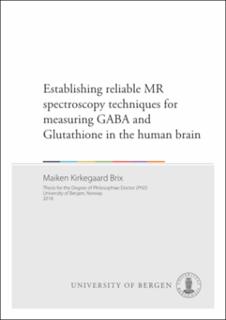| dc.contributor.author | Brix, Maiken Kirkegaard | en_US |
| dc.date.accessioned | 2018-08-07T12:28:47Z | |
| dc.date.available | 2018-08-07T12:28:47Z | |
| dc.date.issued | 2018-05-03 | |
| dc.identifier.isbn | 978-82-308-3765-8 | en_US |
| dc.identifier.uri | https://hdl.handle.net/1956/18019 | |
| dc.description.abstract | Background: Proton MR spectroscopy (MRS) is a well-established method for measuring the relative concentration of a wide range of metabolites in the human brain noninvasively. Lately, more advanced spectroscopic techniques, such as MEGAPRESS, have emerged enabling us to measure low concentrated metabolites with complex peak splitting patterns. Examples of such metabolites are the main inhibitory brain neurotransmitter, g-aminobutyric acid (GABA), and the main brain antioxidant, glutathione (GSH). Impairment of both GABA and GSH have been implicated in the pathophysiology of several psychiatric and neurodegenerative disorders, including schizophrenia, bipolar disorder, autism spectrum disorder (ASD), multiple sclerosis, Alzheimer’s disease, amyotrophic lateral sclerosis and Parkinson disease. An accurate and reliable quantification of these metabolites in vivo is therefore of utmost interest and clinical relevance. The PhD started with an ASD focus, setting out to examine brain MRS measurable differences between boys with ASD and controls. The focus, however, soon shifted to the methodological aspect of MRS, with a desire to contribute in establishing reliable MRS techniques for measuring GABA and GSH in the human brain. Aims: The aim of the ASD study was to explore the excitatory/inhibitory hypothesis in children with ASD by looking for imbalances in brain metabolites in boys with ASD compared with typically developing controls with standard and advanced MRS techniques. Validating GABA and GSH edited MEGA-PRESS, and comparing these sequences to the standard single voxel measurements; short TE STEAM and PRESS sequence. Methods: Four different studies were performed, all on a 3.0 T GE MRI scanner. The ASD study: 14 boys with ASD and 24 age-matched controls were examined with both the GABA edited MEGA-PRESS and PRESS sequence. Autism symptom severity were reported by the Autism Spectrum Screening Questionnaire (ASSQ). The GABA reprod study: Two 20 min long GABA edited MEGA-PRESS acquisition were performed in 21 healthy young male volunteers. The participants were scanned twice with identical protocols. By applying a timewindowing approach, within-and between-session reproducibility was calculated. The “Christmas phantom” study: 122 GSH edited MEGA-PRESS and PRESS spectra of a phantom containing GSH were acquired over a time period of 11 days. The resulting decaying GSH curve (GSH oxidizes to GSSG) were modelled. A 1-year-after follow-up acquisition for both sequences was also performed. The GSH reprod study: GSH edited MEGA-PRESS and short TE STEAM and PRESS acquisitions were performed in 36 healthy volunteers. The participants were scanned twice with identical protocols, one week apart. The timewindowing approach was applied for within- and between-session reproducibility for GSH edited MEGA-PRESS. Differences between quantified GSH levels between males and females were examined, and the three different methods of measuring GSH were evaluated. Main Results: There was a significant negative correlation in the ASD group between ASSQ and GABA levels, however there was no significant difference between the ASD group and the control group in MEGA-PRESS measured GABA levels. Increasing the number of repetitions in GABA edited MEGA-PRESS showed improvements for within- and between-session reproducibility up to about 218 paired repetitions (scan length ~ 13 min). Gannet combined with LCModel proved the best method processing the GABA data. Both GSH edited MEGA-PRESS and PRESS were able to measure the degradation of GSH in the phantom, however the modelled GSH edited MEGA-PRESS degradation curve was more accurate than PRESS. Between-session variability of GSH edited MEGA-PRESS stabilised at around 128 paired repetitions (~8 min). There were no significant correlations between GSH measured with MEGA-PRESS, STEAM and PRESS, and no differences in measured GSH levels between males and females. Conclusion: In line with other studies, the ASD participants have GABA values that seem to change with their clinical severity although there was no group difference with healthy controls. For both GABA and GSH, it is possible to acquire reproducible MEGA-PRESS measurements. GSH edited MEGA-PRESS measurements have somewhat higher coefficient of variation (meaning lower reproducibility), but stabilises at a shorter scan length than GABA edited MEGA-PRESS. MEGA-PRESS is more accurate that both PRESS and STEAM in measuring GSH for in vivo measurements. This is also reflected in its in vitro quantification, where the PRESS measurements fit of GSH seem to include oxidised GSH. | en_US |
| dc.publisher | The University of Bergen | eng |
| dc.relation.haspart | Paper I: Brix MK, Ersland L, Hugdahl K, Grüner R, Posserud MB, Hammar Å, Craven AR, Noeske R, Evans JC, Walker HB, Midtveit T, Beyer MK: Brain MR Spectroscopy in Autism Spectrum Disorder –the GABA excitatory/inhibitory imbalance theory revisited. Frontiers in Human Neuroscience 2015. 9: p. 365. <a href="http://hdl.handle.net/1956/18023" target="blank">http://hdl.handle.net/1956/18023</a> | en_US |
| dc.relation.haspart | Paper II: Brix MK, Ersland L, Hugdahl K, Dwyer GE, Grüner R, Noeske R, Beyer MK, Craven AR: Within- and between-session reproducibility of GABA measurements with MR spectroscopy. J Magn Reson Imaging 2017. 46(2): 421-430. The published version is available at: <a href="https://doi.org/10.1002/jmri.25588" target="blank">https://doi.org/10.1002/jmri.25588</a> | en_US |
| dc.relation.haspart | Paper III: Brix MK, Dwyer GE, Grüner R, Noeske R, Craven AR, Ersland L: MEGAPRESS and PRESS measure oxidation of glutathione in a phantom. Submitted. Full-text not available in BORA. | en_US |
| dc.relation.haspart | Paper IV: Brix MK, Craven AR, Hugdahl K, Grüner R, Noeske R, Beyer MK, Ersland L: Reproducibility of GSH measurements in MR spectroscopy. Manuscript in preparation. Full-text not available in BORA. | en_US |
| dc.title | Establishing reliable MR spectroscopy techniques for measuring GABA and Glutathione in the human brain | en_US |
| dc.type | Doctoral thesis | |
| dc.rights.holder | Copyright the author. All rights reserved. | |
| dc.subject.nsi | VDP::Medisinske Fag: 700::Klinisk medisinske fag: 750::Radiologi og bildediagnostikk: 763 | en_US |
